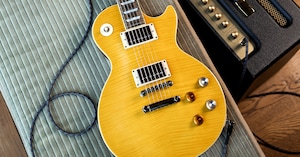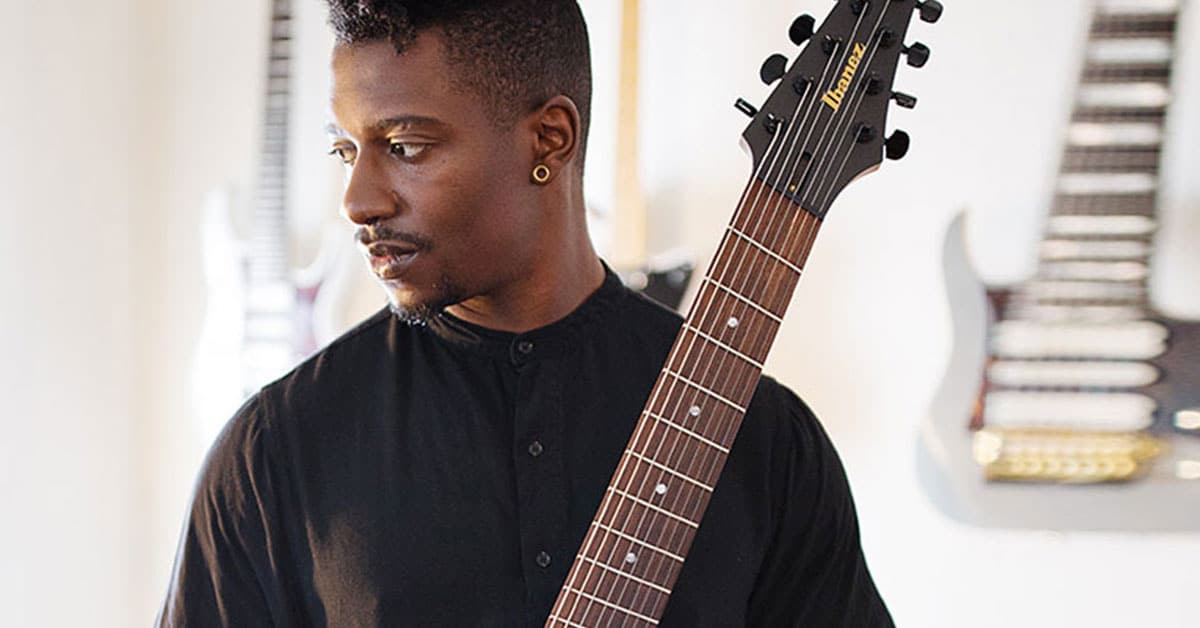Talking tone, extended range and more with the Animals As Leaders guitarist
Tosin Abasi doesn’t easily fit into categorization. His progressive rock group Animals As Leaders found success without a vocalist. He blends rhythm and harmony from jazz, classical, flamenco and blues into his own metal fusion. Even the six-string electric guitar itself gets a pass, as Abasi prefers to create music with the extended range of an eight-string instrument.
After gaining recognition in his hometown with the Washington, D.C.-based metalcore act Reflux, Abasi released his debut solo album under the name Animals As Leaders in 2009, using drum loops and playing all the instruments himself. The second recording, Weightless, and subsequent releases were done as a trio, with their fifth full-length album being released in the fall.
“Animals As Leaders is definitely my attempt at a perfect project, where I get to do whatever I want with the influences I have without it being against the rules.”Defying Categorization
True to his alternative guitar hero status, Abasi didn’t start out on a stringed instrument. “Actually, my first instrument was the clarinet. I was in the school orchestra … that was cool. I learned to read music and it was gratifying but the guitar, I think, was more relevant to the music I was listening to.” He explains, “ … alternative rock was really big … bands like Nirvana and Smashing Pumpkins and all that stuff … I think stringed instruments really communicate a lot of the player. There’s just this sort of … as an interface it’s just really connected to the player. You hear a lot of the nuance and the guitar is just so woven into our culture … it’s a great instrument.”

Wider Range of Frequencies
After a solid base learned on his own from the legendary guitarists before him, Abasi gravitated to the eight-string electric. “… Guys like Steve Vai and even bands like Korn, you know, started using extended-range guitar and when I started playing seven-string, I didn’t really know much music theory so I was very much into just exploring the fretboard and hearing cool sounds … it didn’t necessarily throw me off to have an extra string.” He says, “I was just writing riffs and I noticed that there were more riffs to be written. Once I started to really understand the fretboard, I realized there were a lot of advantages to having more than six strings with chord voicings, tapping and arpeggio shapes … I stayed on a seven-string for five or six years until Meshuggah put out an album called Nothing and it was eight-string guitar. It was the first time I ever heard it and I was like, ‘What is even happening?’”
From decidedly metal beginnings on the eight-string guitar, Abasi expanded his listening soon after. “There’s a guitarist named Charlie Hunter who plays eight-string guitar in a totally different way than Meshuggah does. He emulates bass and guitar at the same time, so he’s doing walking bass lines and comping chords and improvising all on one guitar.” He continues, “… You have the benefit of a wider range of frequencies so you don’t feel like you’re just writing necessarily one part or one range of the spectrum. You feel like you can actually write for bass as well as in the treble area. And then the last feature … you can incorporate bass technique. So I do a lot of slap and thumping and it just sounds really aggressive and powerful on the lower strings. So—perfect storm.”
Noticing a good number of his favorite players using Ibanez guitars, Abasi explored that line of instruments early on. “Ibanez was always visible because of the players I was learning from … really looking up to … Vai and Satriani … all playing Ibanez. Experimentally playing the guitars, I really liked the flat radius, the thin necks—they were just like shred guitars. They played faster. They were super comfortable. I liked the aesthetics. They were always a brand that I naturally wanted to play and then, paralleling my growth as far as getting into extended range, they were one of the first major manufacturers to do a seven-string guitar—and it’s a great instrument.” Abasi explains, “I feel like they actually helped to validate the extended range guitar because of how well they make the instruments in the first place. And then even with the eight-string, they were the first major manufacturer I was aware of to really produce an eight-string you could buy off the shelf. As far as my relationship with them, I just knew that they were into innovation … they were the perfect home for me and my ideas. And with my first signature guitar, I kind of used the RG as a platform to make my perfect eight-string RG. But with the prototype guitars, I moved into different territory and they were open to new body shape and incorporating fan frets and a lot of design features they hadn’t done before—which is awesome.”

Signature Sound
The first signature model Ibanez produced for Tosin Anasi was the TAM100. “I was pretty happy with the RG2228 that existed but I wanted to add a few more features that would allow me to express myself more accurately … I voiced some pickups that I felt could really reflect my range of tones. Everything from the tapping to sweeping to straight-up rhythm guitar to really crystalline clean, so we did a moderate output pickup and we came up with a sort of pickup routing that allowed for quite a few different options.” Abasi also has a lower-priced model in the line, the TAM10. “It’s basically a slightly edited version of the TAM100. You got the same pickups and the same routing configuration. But you have a slightly different bridge and you have a maple neck. It gives me a slightly different tone and so I use this for certain things … it’s a great guitar.”
Another part Abasi’s sound is his amplifier, which can be a challenge with extended range guitars. “I was at Seymour Duncan’s office and we were trying out a pedal … they happened to have a Morgan amp there to plug it into.” He says, “I’m just demoing this pedal and I’m like, ‘wait, what amp is this? This thing sounds really good.’… it turned out to be the SW … I was like, ‘Man, this thing sounds huge, super articulate, just gorgeous.’ I just felt very connected to the amp.”
An artist putting all his influences together in one project is a rarity, but it’s a vision Abasi has successfully translated to his group for many years. “Animals As Leaders is definitely my attempt at a perfect project, where I get to do whatever I want with the influences I have without it being against the rules. It incorporates complex harmony, complex rhythm and even my love of electronic music and textures, and there’s a thread of just me through it. So there’s a continuity of just my aesthetic. But for the most part, it is an attempt to merge things like jazz harmony and classical counterpoint, shred guitar, odd meter—all of the above into one thing.”
Although a unique choice at the time, Abasi keeping the group instrumental was the plan from the first album. “I was in a band with vocals and the offer to do a solo guitar album came up … at the time I wasn’t too into it. After going to music school … the Atlanta Institute of Music … I was more comfortable with the guitar and I had a bunch of material that I think stood on its own as instrumental music. So, the idea with Animals As Leaders was to be an instrumental band, the same way I love bands like Tortoise and things like Squarepusher and Aphex Twin.”

New Ideas and Different Directions
Always moving forward, Abasi and the other two members of Animals As Leaders have taken over production and engineering duties themselves. “We’ve always had someone step in to be the role of engineer or producer … but this album is done totally just the three of us.” Abasi explains, “I think it’s the most balanced representation of the three of us … I think in a weird way, it’s like our first album or it’s really one where I feel like the three of us together are totally necessary to make it what it is.” He continues, “We took about a year off between our last tour and completing this album and I just kind of spent a lot of time playing different guitars. Playing the nylon-string. Playing various six-strings. Just to flesh out new ideas in different directions and then we did have a few rehearsals where we wanted to see what would happen if we jammed stuff out as opposed to recording straight into the computer and sequencing that way.”
Tosin Abasi’s new material – and his signature Ibanez guitars – can be heard on the forthcoming Animals As Leaders release, with a worldwide tour to follow. Information about the album and the latest live shows can be found at animalsasleaders.com.




